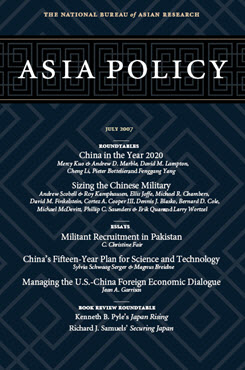China's Fifteen-Year Plan for Science and Technology
An Assessment
The essay provides a critical assessment of China’s latest fifteen-year plan for science and technology.
EXECUTIVE SUMMARY
MAIN ARGUMENT
The latest long-term plan for science and technology reflects China’s determination both to overcome growing domestic social and environmental problems through technology and to become a world leader in innovation. The plan presents no radical departure from earlier strategies and continues to define policymaking by a strong belief that innovation can be “decreed” or steered by the government. The plan relies heavily both on supply-side policies for research and education and on a technology-driven view of innovation, rather than tackling less tangible and more complex issues such as deficits in social capital, institution-building, and building an innovation-friendly environment. New targets to strengthen “independent” or “indigenous” innovation raise concerns abroad over the emergence of “techno-nationalism” and implications for China’s future economic openness.
POLICY IMPLICATIONS
This essay identifies two policy implications for China:
- Rather than focus on a possible conflict between imported and indigenous innovation, policymaking would benefit more by concentrating efforts on how to increase positive spillovers from foreign R&D. Helpful would be if policies aimed to improve the ability of companies, consumers, and institutions to generate but also to receive, absorb, and internalize knowledge as well as new ideas, products, and processes.
- In addition to natural sciences and technology-driven innovation, policy efforts would benefit from focusing on markets and consumers, organizational and process innovation, social capital, and (particularly) trust and institution-building.
The essay identifies three policy implications for the international community:
- China’s development is part of a fundamental shift in the international distribution of knowledge. Other countries would benefit by responding positively and constructively to this development and working to better understand China’s innovation system.
- China’s new ability to both attract and provide knowledge resources offers significant opportunities for mutually beneficial exchange and cooperation in research and education.
- By working with China, the international community might prevent technonationalistic tendencies from steering China toward protectionism.
About Asia Policy
Asia Policy is a peer-reviewed scholarly journal presenting policy-relevant academic research on the Asia-Pacific that draws clear and concise conclusions useful to today’s policymakers. Asia Policy is published quarterly in January, April, July, and October and accepts submissions on a rolling basis. Learn more


